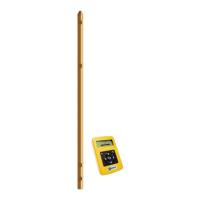MANUAL – REFLEX EZ-TRAC™ | 18
For a surface drill program, place the instrument in the location you
plan to drill before the drill arrives. If that is not feasible, place the
instrument as near the borehole as possible but away from any
magnetic interference. Use the instrument to measure the
background magnetic field strength and the magnetic dip and store
this magnetic reference in the control unit.
As an alternative, you can compile both values from your on-going
drill program along with the geology and magnetic susceptibility. This
will give you a good idea of what the background magnetic field value
is.
At the mine site the first option may not be possible due to all the man
made disturbances. In this case, the determination of the background
magnetic field value should be done by compiling the data from the
actual boreholes to establish the baseline. The magnetic reference is
possible to enter manually in
REFLEX™ SProcess.
5.3.3 Magnetic threshold
A reasonable amount of natural variation of the magnetic field
strength is ±1,000 nT and ±0.5 degrees for the magnetic dip.
In the
REFLEX™ EZ-COM unit, the accepted range is ±1,000 nT from
the magnetic field strength reference value, and ±0.5 deg from the
magnetic dip reference value. For survey stations that are outside the
accepted range, values which depend on input from the magnetic
sensors will be highlighted.
5.3.4 Quality control
Using the quality checks on a daily basis will allow you to get familiar
with your measurements, which will ensure quality interpretations of
the survey data.
The measurements of the total magnetic field strength and magnetic
dip are useful in determining the integrity of the data.
A magnetic anomaly may cause changes in either or both magnetic
field values. It is therefore vital that you examine the magnetic field
strength and magnetic dip at every station. Small changes in either
parameter indicate a disturbance that may be upsetting the measured
azimuth, and therefore the survey accuracy.
5.3.5 Filter out bad data
There is nothing you can do to change the measured azimuth
because there is no way of calculating, or even estimating, the
magnitude of the error. What you can do, is to filter out those
measured stations you believe to have been upset by some sort of
magnetic anomaly.
Filtering functionality, which automatically excludes erroneous data, is
included in
REFLEX™ SProcess.
Filtering must be used with care. A magnetic anomaly could be
concealing or exaggerating a natural deviation of the hole. Even if
these stations are excluded, it might not be possible to get an
accurate survey.

